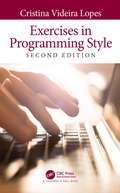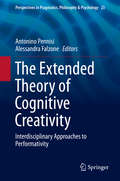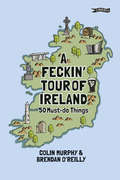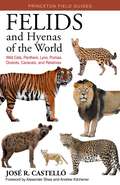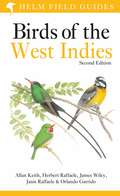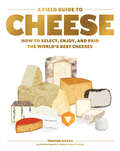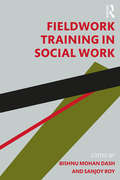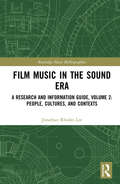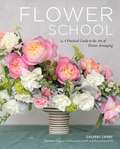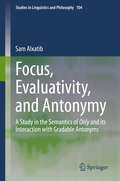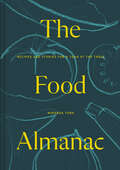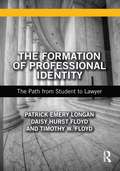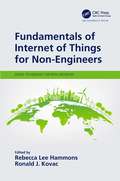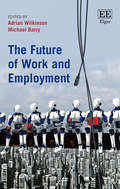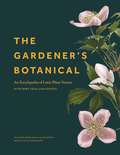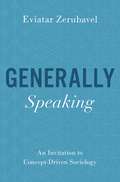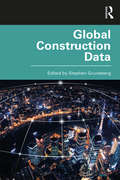- Table View
- List View
Exercises in Programming Style
by Cristina Videira LopesThe first edition of Exercises in Programming Style was honored as an ACM Notable Book and praised as "The best programming book of the decade." This new edition retains the same presentation but has been upgraded to Python 3, and there is a new section on neural network styles. Using a simple computational task (term frequency) to illustrate different programming styles, Exercises in Programming Style helps readers understand the various ways of writing programs and designing systems. It is designed to be used in conjunction with code provided on an online repository. The book complements and explains the raw code in a way that is accessible to anyone who regularly practices the art of programming. The book can also be used in advanced programming courses in computer science and software engineering programs. The book contains 40 different styles for writing the term frequency task. The styles are grouped into ten categories: historical, basic, function composition, objects and object interactions, reflection and metaprogramming, adversity, data-centric, concurrency, interactivity, and neural networks. The author states the constraints in each style and explains the example programs. Each chapter first presents the constraints of the style, next shows an example program, and then gives a detailed explanation of the code. Most chapters also have sections focusing on the use of the style in systems design as well as sections describing the historical context in which the programming style emerged.
Exercises in Programming Style
by Cristina Videira LopesThe first edition of Exercises in Programming Style was honored as an ACM Notable Book and praised as "The best programming book of the decade." This new edition retains the same presentation but has been upgraded to Python 3, and there is a new section on neural network styles. Using a simple computational task (term frequency) to illustrate different programming styles, Exercises in Programming Style helps readers understand the various ways of writing programs and designing systems. It is designed to be used in conjunction with code provided on an online repository. The book complements and explains the raw code in a way that is accessible to anyone who regularly practices the art of programming. The book can also be used in advanced programming courses in computer science and software engineering programs. The book contains 40 different styles for writing the term frequency task. The styles are grouped into ten categories: historical, basic, function composition, objects and object interactions, reflection and metaprogramming, adversity, data-centric, concurrency, interactivity, and neural networks. The author states the constraints in each style and explains the example programs. Each chapter first presents the constraints of the style, next shows an example program, and then gives a detailed explanation of the code. Most chapters also have sections focusing on the use of the style in systems design as well as sections describing the historical context in which the programming style emerged.
The Extended Theory of Cognitive Creativity: Interdisciplinary Approaches to Performativity (Perspectives in Pragmatics, Philosophy & Psychology #23)
by Antonino Pennisi Alessandra FalzoneThis edited volume focuses on the hypothesis that performativity is not a property confined to certain specific human skills, or to certain specific acts of language, nor an accidental enrichment due to creative intelligence. Instead, the executive and motor component of cognitive behavior should be considered an intrinsic part of the physiological functioning of the mind, and as endowed with self-generative power. Performativity, in this theoretical context, can be defined as a constituent component of cognitive processes. The material action allowing us to interact with reality is both the means by which the subject knows the surrounding world and one through which he experiments with the possibilities of his body. This proposal is rooted in models now widely accepted in the philosophy of mind and language; in fact, it focuses on a space of awareness that is not in the individual, or outside it, but is determined by the species-specific ways in which the body acts on the world. This theoretical hypothesis will be pursued through the latest interdisciplinary methodology typical of cognitive science, that coincide with the five sections in which the book is organized: Embodied, enactivist, philosophical approaches; Aesthetics approaches; Naturalistic and evolutionary approaches; Neuroscientific approaches; Linguistics approaches. This book is intended for: linguists, philosophers, psychologists, cognitive scientists, scholars of art and aesthetics, performing artists, researchers in embodied cognition, especially enactivists and students of the extended mind.
A Feckin' Tour of Ireland: 50 Must Do Things
by Colin MurphyThe Emerald Isle has something for everyone, from the stupendous coastline and cliffs of the Wild Atlantic Way in the west to the culture and cuisine of the Ancient East; from the castles and forts of the historic north to the famed golden beaches of the beautiful south – and not forgetting the mighty craic and decent watering holes to be found everywhere in between! Humorous information about 50 key tourist attractions in Ireland, accompanied by photographs and illustrations. A light-hearted guide of Ireland for natives and visitors alike. Featured destinations include: The Game of Thrones Tour The Giant’s Causeway Coastal Route Kilmainham Gaol Glasnevin Cemetery & Museum Newgrange, Knowth and Dowth Powerscourt House & Gardens King John’s Castle Irish National Stud & Gardens Yeats Country
Felids and Hyenas of the World: Wildcats, Panthers, Lynx, Pumas, Ocelots, Caracals, and Relatives
by Dr. José R. CastellóThe most comprehensive and user-friendly photographic field guide to the world’s wildcats and hyenasFrom the Leopard Cat of Asia, the Black-footed Cat of Africa, and the Amur Tiger of Siberia to South America’s Ocelots and North America’s Bobcats, the wildcats known as felids are among the most fascinating and spectacular of all animals. This stunningly illustrated book is the most comprehensive and user-friendly guide to the world’s felids and their often misunderstood relative, the hyenas. Covering and illustrating every species and subspecies, the guide features more than 150 superb full-color plates that incorporate more than 600 photographs and show species in similar poses for quick and easy comparison. Drawing on the latest taxonomy and research, the facing-page species accounts provide distribution maps, common and scientific names, and detailed information on key identification features, distribution, behavior, reproduction, similar species, habitat, conservation status, and where to observe each species. An ideal field companion for use anywhere in the world, the book will appeal to both casual nature enthusiasts and seasoned professionals.Covers 41 felids and 4 hyenas—every species and subspecies in the worldFeatures more than 150 color plates incorporating more than 600 photosDepicts species in similar poses for quick and easy comparisonsProvides key identification information in detailed, facing-page species accountsUses the latest taxonomyIncludes easy-to-read distribution maps and tips on where to observe each species
Felids and Hyenas of the World: Wildcats, Panthers, Lynx, Pumas, Ocelots, Caracals, and Relatives
by Dr. José R. CastellóThe most comprehensive and user-friendly photographic field guide to the world’s wildcats and hyenasFrom the Leopard Cat of Asia, the Black-footed Cat of Africa, and the Amur Tiger of Siberia to South America’s Ocelots and North America’s Bobcats, the wildcats known as felids are among the most fascinating and spectacular of all animals. This stunningly illustrated book is the most comprehensive and user-friendly guide to the world’s felids and their often misunderstood relative, the hyenas. Covering and illustrating every species and subspecies, the guide features more than 150 superb full-color plates that incorporate more than 600 photographs and show species in similar poses for quick and easy comparison. Drawing on the latest taxonomy and research, the facing-page species accounts provide distribution maps, common and scientific names, and detailed information on key identification features, distribution, behavior, reproduction, similar species, habitat, conservation status, and where to observe each species. An ideal field companion for use anywhere in the world, the book will appeal to both casual nature enthusiasts and seasoned professionals.Covers 41 felids and 4 hyenas—every species and subspecies in the worldFeatures more than 150 color plates incorporating more than 600 photosDepicts species in similar poses for quick and easy comparisonsProvides key identification information in detailed, facing-page species accountsUses the latest taxonomyIncludes easy-to-read distribution maps and tips on where to observe each species
Field Guide to Birds of the West Indies: Second Edition
by Allan Keith Herbert Raffaele Janis Raffaele James Wiley Orlando GarridoBirds of the West Indies is the first field guide that covers and depicts all birds known to occur in the region, including infrequently occurring and introduced forms. Now fully updated and expanded, this stunningly illustrated book features detailed accounts of more than 600 species, describing field marks, range, status, voice and habitat. More than 100 beautiful colour plates depict plumages of all species, and the book includes distribution maps, a colour code for endemics, and an incisive introduction that discusses avifaunal changes in the West Indies over the past fifteen years.
A Field Guide to Cheese: How to Select, Enjoy, and Pair the World's Best Cheeses
by Tristan SicardThe ultimate cheese compendium—the only illustrated cheese guide on the market—with profiles of more than 400 cheeses from around the world, maps of their production, and guides for the perfect pairings.
Fieldwork Training in Social Work
by Bishnu Mohan Dash Sanjoy RoyThis volume is a definitive manual for students and practitioners involved in learning and developing essential theories and models for fieldwork practicum in social work education. It addresses various functional issues in field practicum, delineates proper guidelines for students and supervisors, discusses criteria of supervision and evaluation, and explores the concerns facing South Asian field practitioners. The volume focuses on traditional and non-traditional components and aspects of fieldwork and training, such as: • The value and use of educational camps and skill development workshops. • The contemporary field-level needs and strategies in social work practicum. • Formulating alternative practice theories that will allow social work practitioners to respond to the critical social problems unique to India and South Asia. The book provides multiple frameworks for teaching and learning fieldwork that integrate theory and practice and create an environment where students can develop intervention strategies using their knowledge, skills, and techniques. The volume will be indispensable reading for undergraduate and post-graduate students of social work. It will also be useful for scholars of sociology, anthropology, and development studies, and practitioners engaged in various non-governmental and international organizations.
Fieldwork Training in Social Work
by Bishnu Mohan Dash Sanjoy RoyThis volume is a definitive manual for students and practitioners involved in learning and developing essential theories and models for fieldwork practicum in social work education. It addresses various functional issues in field practicum, delineates proper guidelines for students and supervisors, discusses criteria of supervision and evaluation, and explores the concerns facing South Asian field practitioners. The volume focuses on traditional and non-traditional components and aspects of fieldwork and training, such as: • The value and use of educational camps and skill development workshops. • The contemporary field-level needs and strategies in social work practicum. • Formulating alternative practice theories that will allow social work practitioners to respond to the critical social problems unique to India and South Asia. The book provides multiple frameworks for teaching and learning fieldwork that integrate theory and practice and create an environment where students can develop intervention strategies using their knowledge, skills, and techniques. The volume will be indispensable reading for undergraduate and post-graduate students of social work. It will also be useful for scholars of sociology, anthropology, and development studies, and practitioners engaged in various non-governmental and international organizations.
Film Music in the Sound Era: A Research and Information Guide, Volume 2: People, Cultures, and Contexts (Routledge Music Bibliographies)
by Jonathan Rhodes LeeFilm Music in the Sound Era: A Research and Information Guide offers a comprehensive bibliography of scholarship on music in sound film (1927–2017). Thematically organized sections cover historical studies, studies of musicians and filmmakers, genre studies, theory and aesthetics, and other key aspects of film music studies. Broad coverage of works from around the globe, paired with robust indexes and thorough cross-referencing, make this research guide an invaluable tool for all scholars and students investigating the intersection of music and film. This guide is published in two volumes: Volume 1: Histories, Theories, and Genres covers overviews, historical surveys, theory and criticism, studies of film genres, and case studies of individual films. Volume 2: People, Cultures, and Contexts covers individual people, social and cultural studies, studies of musical genre, pedagogy, and the Industry. A complete index is included in each volume.
Film Music in the Sound Era: A Research and Information Guide, Volume 2: People, Cultures, and Contexts (Routledge Music Bibliographies)
by Jonathan Rhodes LeeFilm Music in the Sound Era: A Research and Information Guide offers a comprehensive bibliography of scholarship on music in sound film (1927–2017). Thematically organized sections cover historical studies, studies of musicians and filmmakers, genre studies, theory and aesthetics, and other key aspects of film music studies. Broad coverage of works from around the globe, paired with robust indexes and thorough cross-referencing, make this research guide an invaluable tool for all scholars and students investigating the intersection of music and film. This guide is published in two volumes: Volume 1: Histories, Theories, and Genres covers overviews, historical surveys, theory and criticism, studies of film genres, and case studies of individual films. Volume 2: People, Cultures, and Contexts covers individual people, social and cultural studies, studies of musical genre, pedagogy, and the Industry. A complete index is included in each volume.
Flower School: A Practical Guide to the Art of Flower Arranging
by Calvert CraryCreate the flower arrangements of your dreams to keep at home, take to the office, or display on any special occasion using the simple tips and tricks and masterful techniques taught by Executive Director and professor Calvert Crary and the master florists at FlowerSchool New York.FlowerSchool New York is one of the world's premiere institutes for floral design and artistry, offering career development courses certified by the New York State Board of Education, and exclusive master class programs taught by celebrated master florists including Kiana Underwood, Remco Van Vliet, Lewis Miller, Emily Thompson, and Ingrid Carozzi. Now, for the first time, FlowerSchool Executive Director Calvert Crary is publishing a book that will make it possible for even the greenest at-home arrangers to create gorgeous, Instagram worthy bouquets. This hands-on, comprehensive guide provides readers with step-by-step instructions that cover all the most crucial aspects of flower arranging, including:How to buy the best flowers and how to get the best pricesSelecting your flowers based on texture, color, and seasonalityConditioning your flowers to ensure they last as long as possiblePairing your flowers with the right vaseCreating arrangements in a wide variety of styles that will work for any occasionIncluding advice from the school's well-respected master florists, and featuring beautiful color photographs of each unique arrangement, Flower School offers invaluable, insider tips and tricks that can only be gained through years of experience, providing readers with the fundamental tools and education they need to create homemade floral arrangements that are on par with any professional design.
Focus, Evaluativity, and Antonymy: A Study in the Semantics of Only and its Interaction with Gradable Antonyms (Studies in Linguistics and Philosophy #104)
by Sam AlxatibThis book uncovers properties of focus association with 'only' by examining the interaction between the particle and bare (or “evaluative”) gradable terms. Its empirical building blocks are paradigms involving upward-scalar terms like 'few' and 'rarely', and their downward-scalar antonyms 'many' and 'frequently', an area that has not been studied previously in the literature. The empirical claim is that associations of the former type give rise to unexpected readings, and the proposed theoretical explanation draws on the properties of the latter type of association. In presenting the details, the book deconstructs the so-called scalar presupposition of 'only' and derives it from constraints against its vacuous use. This view is then combined with a semantics of the evaluative adjectives 'many' and 'few' to explain why the unavailable (but expected) meanings of the given constructions are unavailable. The attested (but unexpected) readings of 'only+few/rarely' associations are derived from independently motivated LFs in which the degree expressions are existentially closed. Finally, the book provides new findings, based on the core proposal, about 'only if' constructions, and about the interaction between 'only' and other upward-scalar modified numerals (comparatives, and 'at most'). The book thus provides new data and a new theoretical view of the semantic properties of 'only', and connects it to the semantics of gradable expressions.
The Food Almanac: Recipes And Stories For A Year At The Table
by Miranda YorkSHORTLISTED FOR THE FORTNUM & MASON FOOD AND DRINK AWARDS 2021 The Food Almanac is a seasonal collection of recipes and stories celebrating the joy of food – a dazzling, diverse mix of memoir, history, short stories and poems alongside recipes, cooking tips, menus and reading lists.
The Formation of Professional Identity: The Path from Student to Lawyer
by Patrick Emery Longan Daisy Hurst Floyd Timothy W. FloydBecoming a lawyer is about much more than acquiring knowledge and technique. As law students learn the law and acquire some basic skills, they are also inevitably forming a deep sense of themselves in their new roles as lawyers. That sense of self – the student’s nascent professional identity – needs to take a particular form if the students are to fulfil the public purposes of lawyers and find deep meaning and satisfaction in their work. In this book, Professors Patrick Longan, Daisy Floyd, and Timothy Floyd combine what they have learned in many years of teaching and research concerning the lawyer’s professional identity with lessons derived from legal ethics, moral psychology, and moral philosophy. They describe in depth the six virtues that every lawyer needs as part of his or her professional identity, and they explore both the obstacles to acquiring and deploying those virtues and strategies for overcoming those impediments. The result is a straightforward guide for law students on how to cultivate a professional identity that will allow them to make a meaningful difference in the lives of others and to flourish as individuals.
The Formation of Professional Identity: The Path from Student to Lawyer
by Patrick Emery Longan Daisy Hurst Floyd Timothy W. FloydBecoming a lawyer is about much more than acquiring knowledge and technique. As law students learn the law and acquire some basic skills, they are also inevitably forming a deep sense of themselves in their new roles as lawyers. That sense of self – the student’s nascent professional identity – needs to take a particular form if the students are to fulfil the public purposes of lawyers and find deep meaning and satisfaction in their work. In this book, Professors Patrick Longan, Daisy Floyd, and Timothy Floyd combine what they have learned in many years of teaching and research concerning the lawyer’s professional identity with lessons derived from legal ethics, moral psychology, and moral philosophy. They describe in depth the six virtues that every lawyer needs as part of his or her professional identity, and they explore both the obstacles to acquiring and deploying those virtues and strategies for overcoming those impediments. The result is a straightforward guide for law students on how to cultivate a professional identity that will allow them to make a meaningful difference in the lives of others and to flourish as individuals.
Fundamentals of Internet of Things for Non-Engineers (Technology for Non-Engineers)
by Rebecca Lee Hammons Ronald J. KovacThe IoT is the next manifestation of the Internet. The trend started by connecting computers to computers, progressed to connecting people to people, and is now moving to connect everything to everything. The movement started like a race—with a lot of fanfare, excitement, and cheering. We’re now into the work phase, and we have to figure out how to make the dream come true. The IoT will have many faces and involve many fields as it progresses. It will involve technology, design, security, legal policy, business, artificial intelligence, design, Big Data, and forensics; about any field that exists now. This is the reason for this book. There are books in each one of these fields, but the focus was always "an inch wide and a mile deep." There’s a need for a book that will introduce the IoT to non-engineers and allow them to dream of the possibilities and explore the work venues in this area. The book had to be "a mile wide and a few inches deep." The editors met this goal by engaging experts from a number of fields and asking them to come together to create an introductory IoT book. Fundamentals of Internet of Things for Non-Engineers Provides a comprehensive view of the current fundamentals and the anticipated future trends in the realm of Internet of Things from a practitioner’s point of view Brings together a variety of voices with subject matter expertise in these diverse topical areas to provide leaders, students, and lay persons with a fresh worldview of the Internet of Things and the background to succeed in related technology decision-making Enhances the reader’s experience through a review of actual applications of Internet of Things end points and devices to solve business and civic problems along with notes on lessons learned Prepares readers to embrace the Internet of Things era and address complex business, social, operational, educational, and personal systems integration questions and opportunities
Fundamentals of Internet of Things for Non-Engineers (Technology for Non-Engineers)
by Rebecca Lee Hammons Ronald J. KovacThe IoT is the next manifestation of the Internet. The trend started by connecting computers to computers, progressed to connecting people to people, and is now moving to connect everything to everything. The movement started like a race—with a lot of fanfare, excitement, and cheering. We’re now into the work phase, and we have to figure out how to make the dream come true. The IoT will have many faces and involve many fields as it progresses. It will involve technology, design, security, legal policy, business, artificial intelligence, design, Big Data, and forensics; about any field that exists now. This is the reason for this book. There are books in each one of these fields, but the focus was always "an inch wide and a mile deep." There’s a need for a book that will introduce the IoT to non-engineers and allow them to dream of the possibilities and explore the work venues in this area. The book had to be "a mile wide and a few inches deep." The editors met this goal by engaging experts from a number of fields and asking them to come together to create an introductory IoT book. Fundamentals of Internet of Things for Non-Engineers Provides a comprehensive view of the current fundamentals and the anticipated future trends in the realm of Internet of Things from a practitioner’s point of view Brings together a variety of voices with subject matter expertise in these diverse topical areas to provide leaders, students, and lay persons with a fresh worldview of the Internet of Things and the background to succeed in related technology decision-making Enhances the reader’s experience through a review of actual applications of Internet of Things end points and devices to solve business and civic problems along with notes on lessons learned Prepares readers to embrace the Internet of Things era and address complex business, social, operational, educational, and personal systems integration questions and opportunities
The Future of Work and Employment
by Adrian Wilkinson Michael BarryThis cutting-edge book charts the latest ideas and concepts in employment relations research. Mapping out the intellectual boundaries of the field, The Future of Work and Employment outlines the key research and policy outcomes for work and employment in the age of digitisation and artificial intelligence. Internationally renowned contributors unpack the implications of the latest developments in employment relations, from the rise of the gig economy to the role of platform companies, from perspectives such as employment (in)security, equity, fairness, wellbeing and voice. Reviewing the extant literature on the future of work, and exploring the biggest issues facing the modern workforce, this book argues for a research base that allows more sober reflections on the grand claims that dictate the future of work. Empirically-grounded and incisively-argued, the book forms critical reading for both undergraduate and postgraduate students of business and human resource management, featuring insight into the latest developments in the field. Researchers, policymakers and practitioners will also benefit from its implications for policy and its blending of theory and practice.
The Gardener's Botanical: An Encyclopedia of Latin Plant Names - with More than 5,000 Entries
by Ross BaytonThe definitive guide to botanical LatinUnlock the secrets of botanical Latin with this beautifully illustrated encyclopedia. The Gardener's Botanical contains definitions of more than 5,000 plant names—from abbreviatus ("shortened") to zonatus ("with bands")—along with more than 350 color illustrations.Scientific plant names are an invaluable tool for those who understand them. Formed from Greek and, more commonly, from Latin root words, not only do they make it possible for gardeners and botanists to communicate, they also contain a wealth of hidden information. The Gardener's Botanical is the key to unlocking these secrets. This guide contains a breathtaking array of botanical names in alphabetical order. Each word is listed with a pronunciation guide, definition, example plant, and, where appropriate, etymology. Also included in this illuminating guide are special features on important plant genera, fact boxes, essays focusing on the history and importance of Latin names and botanical illustrations, and an index of common names with more than 2,000 popular plants, cross-referenced with their binomial name in Latin.
The Gardener's Botanical: An Encyclopedia of Latin Plant Names - with More than 5,000 Entries
by Ross BaytonThe definitive guide to botanical LatinUnlock the secrets of botanical Latin with this beautifully illustrated encyclopedia. The Gardener's Botanical contains definitions of more than 5,000 plant names—from abbreviatus ("shortened") to zonatus ("with bands")—along with more than 350 color illustrations.Scientific plant names are an invaluable tool for those who understand them. Formed from Greek and, more commonly, from Latin root words, not only do they make it possible for gardeners and botanists to communicate, they also contain a wealth of hidden information. The Gardener's Botanical is the key to unlocking these secrets. This guide contains a breathtaking array of botanical names in alphabetical order. Each word is listed with a pronunciation guide, definition, example plant, and, where appropriate, etymology. Also included in this illuminating guide are special features on important plant genera, fact boxes, essays focusing on the history and importance of Latin names and botanical illustrations, and an index of common names with more than 2,000 popular plants, cross-referenced with their binomial name in Latin.
Generally Speaking: An Invitation to Concept-Driven Sociology
by Eviatar ZerubavelIn this invitation to "concept-driven" sociology, defying the conventional split between "theory" and "methodology" (as well as between "quantitative" and "qualitative" research), Eviatar Zerubavel introduces a yet unarticulated "Simmelian" method of theorizing specifically designed to reveal fundamental, often hidden social patterns. Insisting that it can actually be taught, he examines the theoretico-methodological process (revolving around the epistemic and analytical acts of focusing, generalizing, "exampling," and analogizing) by which concept-driven researchers can distill generic social patterns from the culturally, historically, and domain-specific contexts in which they encounter them empirically. Disregarding conventionally noted substantive variability in order to uncover conventionally disregarded formal commonalities, Generally Speaking draws on cross-cultural, cross-historical, cross-domain, and cross-level analogies in an effort to reveal formal parallels across disparate contexts. Using numerous examples from culturally and historically diverse contexts and a wide range of social domains while also disregarding scale, Zerubavel thus introduces a pronouncedly transcontextual "generic" sociology.
Global Construction Data
by Stephen GrunebergGlobal construction data is vital for contractors, governments, international organisations, policy makers, academic researchers and statisticians. As the global population of the world expands, the sustainability of the built environment raises the political agenda and the need to manage infrastructure and buildings in both urban and rural contexts becomes ever more pressing. How much more can the built environment grow and how can it be managed sustainably? This edited volume addresses how we can find a possible way through the inconsistencies between national construction data sets to devise a consistent approach to national construction data to further the global sustainability agenda and inform policy making. This search begins in Part I, which looks at the methods and definitions used in construction statistics in different countries. Part II considers examples of different types of construction data from the cost of materials, measuring work on high rise buildings and existing stock. In Part III, the authors consider construction data internationally, beginning with the problem of comparing data in different countries using exchange rates and purchasing power parities (PPPs), comparing innovation processes in different countries and looking at the provision of building design internationally. In Part IV, the international theme is continued by comparing accounting practices and company performance in different countries and concludes with an international comparison of construction industries. This book raises awareness of the significance of the construction industry globally and the importance of data to measure it. It informs the discussion of the best ways of handling the consequences of policies affecting the built environment and the effect of the built environment on the rest of the economy and society. It is essential reading for international economists, construction industry consultants, policy makers, construction statisticians and academics.
Global Construction Data
by Stephen GrunebergGlobal construction data is vital for contractors, governments, international organisations, policy makers, academic researchers and statisticians. As the global population of the world expands, the sustainability of the built environment raises the political agenda and the need to manage infrastructure and buildings in both urban and rural contexts becomes ever more pressing. How much more can the built environment grow and how can it be managed sustainably? This edited volume addresses how we can find a possible way through the inconsistencies between national construction data sets to devise a consistent approach to national construction data to further the global sustainability agenda and inform policy making. This search begins in Part I, which looks at the methods and definitions used in construction statistics in different countries. Part II considers examples of different types of construction data from the cost of materials, measuring work on high rise buildings and existing stock. In Part III, the authors consider construction data internationally, beginning with the problem of comparing data in different countries using exchange rates and purchasing power parities (PPPs), comparing innovation processes in different countries and looking at the provision of building design internationally. In Part IV, the international theme is continued by comparing accounting practices and company performance in different countries and concludes with an international comparison of construction industries. This book raises awareness of the significance of the construction industry globally and the importance of data to measure it. It informs the discussion of the best ways of handling the consequences of policies affecting the built environment and the effect of the built environment on the rest of the economy and society. It is essential reading for international economists, construction industry consultants, policy makers, construction statisticians and academics.
